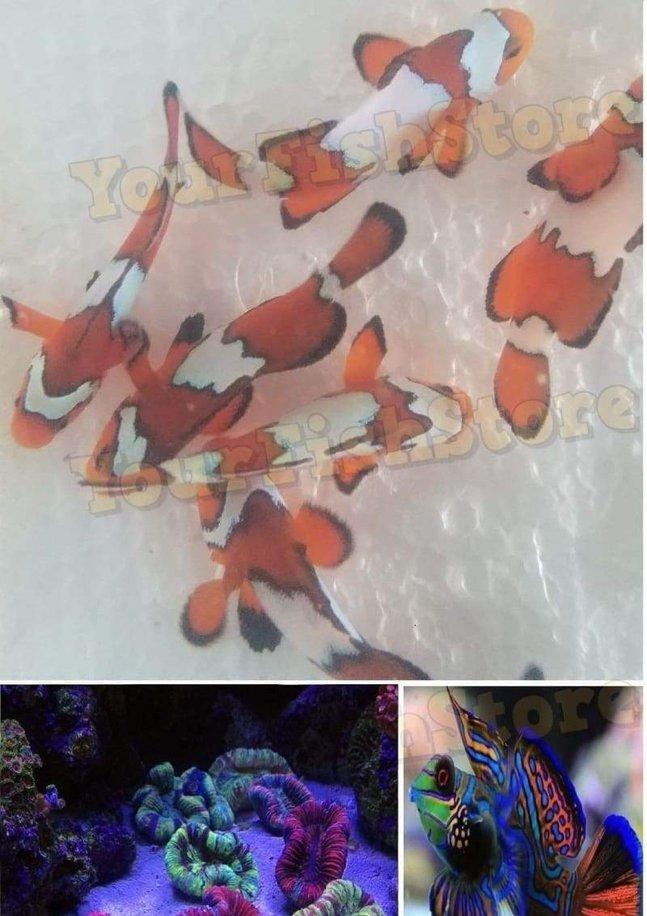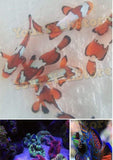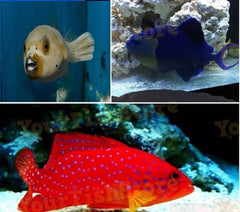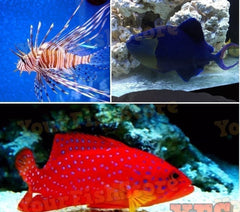X2 Black Ice Clown Fish Med - X1 Assorted Open Brain - X2 Mandarin Gobies Fish

THIS PACKAGE INCLUDES:
x4 BLACK ICE CLOWN FISH MED
x1 ASSORTED OPEN BRAIN
x2 MANDARIN GOBIES
*********************************************************************
x2 BLACK ICE CLOWN FISH MED
*You Will Receive x2 (Two) Black Ice Clown Fish with this package
*Tank Raised *Free Shipping *Premier Breeders *Healthy & Eating Aggressive
Buy from an Official Breeder. We thoroughly inspect each pair before they are sent off to their new home. Each Clown Fish is held for 90 days before they leave our facility insure proper clown gain and aggressive eating habits.
We typically feed all of our clown fish micro .5mm pellets soft/dry, and copepods.
Minimum Tank Size: 20 gallons
Care Level: Easy
Temperament: Peaceful
Reef Compatible: Yes
Water Conditions: 72-78° F, dKH 8-12, pH 8.1-8.4, sg 1.020-1.025
Max. Size: 3"
Color Form: Black, Orange, White
Diet: Omnivore
Compatibility: View Chart
Origin: Captive-Bred - USA
Family: Pomacentridae
This buy, is for two singles that have been paired up together. Check out would be for 1 pair.
Beautiful Clown Fish. The clowns are approx 1" - 1 3/4".
The Black Ice Clownfish is a unique cross between our Premium Snowflake Ocellaris Clownfish and our ultra-black Darwin Ocellaris Clownfish. Like the Snowflake Ocellaris Clownfish, the Black Ice Clownfish has three white body stripes that are exaggerated and have irregular shapes and patterns. The body color is a beautiful orange- brown. The color will darken with maturity. No two fish are the same and this designer clownfish has become increasingly popular for its distinctiveness.
Temperament & Captive Care
The temperament and captive care requirements for the Black Ice Clownfish are very similar to that of the regular Ocellaris Clownfish. It is relatively peaceful and hardy. They thrive in saltwater aquariums with or without an anemone present.
Feeding
Most clownfish are omnivorous feeders, meaning that they will consume a variety of different food types. In nature the diet of clownfish consists of crustaceans (such as copepods and amphipods), algae, polychaete worms, and leftovers from the anemone’s meal. Our captive bred fish are conditioned to eat a variety of aquarium diets including pellets, flake food, frozen Mysis shrimp, and frozen brine shrimp.
Aquarium Host Anemones
Black Ice Clownfish will readily accept a wide variety of host anemones and many hobbyists keep them with the popular and hardy Bubble Tip Anemone (Entacmaea quadricolor). As a reference, the natural host anemones of the regular Ocellaris Clownfish are Magnificent Sea Anemone (Heteractis magnifica), Giant Carpet Sea Anemone (Stichodactyla gigantean) and Merten's Carpet Sea Anemone (Stichodactyla mertensii).
All live stock is shipped FEDEX PRIORITY OVERNIGHT by 10:30am in most areas (USA only). All shipment include Styrofoam for insulation and heat/cold pack to guarantee live delivery.
*****************************************
x2 GREEN MANDARIN GOBY PACKAGE - SALTWATER FISH -FREE SHIPPING
*Medium Size Approx 1 1/2" - 2 1/2" Each
Minimum Tank Size: 30 gallons
Care Level: Moderate
Temperament: Peaceful
Reef Compatible: Yes
Water Conditions: 72-78° F, dKH 8-12, pH 8.1-8.4, sg 1.020-1.025
Max. Size: 4"
Mandarin Gobies, also referred to as Mandarin Dragonets, Mandarinfish, Mandarins, and Psychedelic Gobies, are by-and-by one of the most beautiful and exotic types of fish on the market. Thanks to their mesmerizing stripes and dizzying colors, Mandarins are a super-hot commodity among reef hobbyists.
The Mandarin, with vibrant blue-green rivers of pigment running across its body, is an unmistakable fish that’s sure to be the highlight of your aquarium or refugium. They originate from the warm pacific waters in and around the Indonesia, the Philippines, and Australia.
Despite the fact that Mandarin Gobies are such a staple in the reefing enthusiast’s collection, they still reign supreme as one of the hardest types of fish to keep alive. Letting them thrive is a different story altogether.
The way the Mandarin Goby feeds in the wild (eating large amounts of live shrimp, copepods, and worms) makes for a tough time recreating the conditions. Malnourishment is one of the most common fates to befall a captive Mandarin. Much of the time, they won’t even touch the food you put out for them.
Does that mean you should give up on the Goby and pop for an easier, less finicky fish? Absolutely not. With a little TLC and the right, very specific conditions, Mandarin Gobies can be a breeze to take care of. As gorgeous as they are, you’ll be glad you made the effort.
Introduce this beautiful fish and draw attention to your aquarium. The Green Mandarin Dragonet can never be compared to any other fish. It has the most attractive and vivid coloration and pattern. The Green Mandarin Dragonet features scaleless body in green with orange wavy lines across it. Not only this, its tail is bright red with blue edging. The Green Mandarin Dragonet is also known as Psychedelic fish due to its bizarre coloration. The male fish is larger and also features a large pointed dorsal fin. Although, more often it is named as Mandarin Goby, but they are not gobies, rather they belong to Dragonets family. The Green Mandarin Dragonet is found in groups or pairs, and mainly on sandy bottoms between reef crests, and is indigenous to Philippine area. It is one of the most commonly sold fish, and at the same time it is most delicate in nature and needs care to maintain its longevity, due to its feeding habits. It mainly feeds on live amphipoda and copepods, and these can be found only in larger reef tanks. The Green Mandarin Dragonet is very stringent in eating habits, as some of them can take even frozen foods. It basically use the front fins while looking for the food. The Green Mandarin Dragonet takes lot of time to get adjusted to a captive diet. It is extremely docile as well as non-aggressive, which makes it safe to keep in any aquarium along with other inhabitants. Due to its thick slime covering, it is resistant to parasitic diseases.
*************************************
x1 ASSORTED OPEN BRAIN CORAL - MED - TRACHYPHYLLIA GEOFFROYA - FREE SHIPPING
*This Package is for x2 (TWO) Assorted Open Brain Corals
Approx: 3" - 5" Each
Care Level: Easy
Temperament: Semi-aggressive
Lighting: Moderate
Waterflow: Medium
Placement: Bottom
The Trachyphyllia Brain Coral is also referred to as a Folded Brain, or Crater Coral and is a large polyp stony (LPS) coral. It may have a folded, or figure-eight shape. Its genus name, Trachyphyllia, comes from the Greek trachys (rough) plus phyllon (leaf) because it resembles a rough leaf lying on the sandy bed. There are two common species of Trachphyllia: T. geoffroyi and T. radiata. The T. radiata, which is usually more convoluted in appearance and has fused walls, was formerly called Wellsophyllia radiata, but the genus Wellsophyllia has now been eliminated.
Natural History
These corals get their common name from the grooves and channels on their surfaces that look like the folds of the human brain. There's more than one kind of "brain coral"—several species from two different families of corals share the name—but all help build coral reefs.
Conservation
Coral reefs around the world are in danger. Silt (fine soil) smothers coral when it washes off the land from farm fields, roads and building sites. More towns and resorts near shore mean more sewage, oil and chemicals in the water.
Cool Facts
While staghorn corals grow rapidly to gain new territory, slow-growing brain corals rely on brawn. They hold their ground by being solid and strong enough to withstand the storms that pound more delicate corals to rubble.

QUESTIONS & ANSWERS
Have a Question?
Be the first to ask a question about this.














